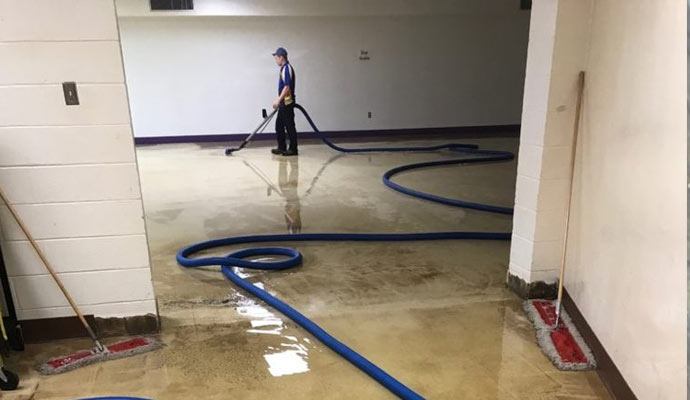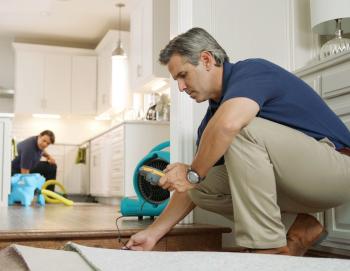Water Damage Restoration 101: Recognizing the Process and Cost
Water damage can strike unexpectedly, leaving house owners in a state of confusion. Understanding the remediation procedure is crucial for efficient recovery. From examining the damage to picking the appropriate provider, each step influences the general result and price. Factors such as the sort of water damage and urgency additionally play a considerable duty. What are the certain techniques used in remediation, and how can one prepare for potential costs?
Kinds Of Water Damage
Water damage can emerge from different sources, each providing unique difficulties for remediation. The three key sorts of water damage are classified based upon contamination degrees: clean water, grey water, and black water. Clean water originates from sources like damaged pipes or rainwater, presenting minimal wellness dangers. Gray water, which includes wastewater from sinks or cleaning devices, has pollutants that might cause discomfort or disease if consumed. Black water, one of the most harmful classification, comes from sewage or floodwaters, consisting of unsafe germs and virus. Each kind requires particular repair strategies and precaution to successfully reduce and resolve the damage health and wellness risks. Recognizing these differences is important for experts and homeowners entailed in the water damage remediation procedure.
Preliminary Evaluation and Examination
A comprehensive first assessment and examination are vital action in the water damage reconstruction procedure. This phase begins with an expert examining the degree of the damage, determining the source of the water invasion, and establishing the kind of water included - Water Damage Restoration. Professionals utilize specific devices to gauge dampness degrees in various products, such as walls, floors, and furniture. Furthermore, they evaluate structural honesty and possible carcinogen, including mold and mildew growth. The searchings for from this examination inform the repair strategy, guiding needed activities and resource appropriation. Precise documents of the damage is essential for insurance coverage claims and future referral. In general, this first evaluation lays the groundwork for reliable repair, making sure a thorough feedback to the certain situation available

Water Extraction Techniques
Following the first analysis, efficient water removal strategies are used to alleviate damage and protect against additional problems. These strategies include using specific devices such as industrial-grade vacuum cleaners and submersible pumps. The choice of method depends on the volume of water present and the sort of products affected. For standing water, completely submersible pumps are usually used for rapid removal, while vacuum cleaners are excellent for extracting water from carpets and upholstery. In addition, advanced methods like water removal mats may be employed for hard-to-reach locations. The goal is to remove as much water as feasible, lessening the potential for mold development and structural damage. Prompt and efficient water extraction is essential in the overall water damage remediation process.
Drying Out and Dehumidification Process
As soon as the water removal is full, the drying and dehumidification procedure becomes critical to restoring the damaged area. This phase generally employs industrial-grade dehumidifiers and air moving companies to properly decrease wetness degrees. The dehumidifiers draw in damp air, eliminating excess moisture, while air movers distribute air to speed up evaporation. Monitoring devices is often made use of to track moisture and temperature levels, ensuring perfect drying out problems. The duration of this process can vary relying on the level of the water damage and environmental factors. It is crucial to completely dry all influenced products, consisting of walls, floor covering, and home furnishings, to prevent mold growth and architectural damage. Correct implementation of this step is important for an effective restoration result.
Cleansing and Sanitizing Afflicted Locations

First Analysis and Examination
Before starting any kind of remediation initiatives, a detailed initial analysis and examination of the influenced locations are crucial for efficient cleansing and sterilizing. This process includes identifying the degree of water damage, figuring out the source of the water invasion, and reviewing the materials affected. Inspectors commonly look for signs of mold development, structural stability problems, and damaged personal belongings. The evaluation also includes inspecting wetness degrees making use of customized equipment to guarantee no surprise water pockets continue to be, as these can bring about further difficulties. Recording the findings is vital for preparing the next action in the reconstruction process. A thorough preliminary assessment makes it possible for remediation experts to design a targeted strategy for effective cleansing and sterilizing, ultimately lessening damage and wellness threats.
Cleaning Strategies and Products
Reliable cleaning and sterilizing of water-damaged locations require a range of strategies and items tailored to the specific materials impacted. For permeable surfaces like drywall and carpets, extraction methods are important to remove excess wetness, complied with by deep cleansing with specialized detergents. Non-porous materials such as tile or metal can be cleaned up utilizing commercial-grade cleansers that successfully eliminate contaminants. Vapor cleaning is an additional reliable method, especially for carpetings and furniture, as it utilizes heats to get rid of germs and mold. Furthermore, environmentally friendly products are progressively prominent for their safety and effectiveness. Eventually, choosing the suitable cleaning approaches and items not just ensures prompt tidiness yet also help in preventing additional damage and wellness risks related to water intrusion.
Sanitization and Disinfection Approaches
When dealing with water damage, proper sanitization and sanitation methods are essential to assure the safety and wellness of the afflicted setting. After preliminary cleaning, surfaces must be treated with ideal disinfectants to get rid of pathogens, mold, and germs that flourish in wet conditions. Common methods consist of using EPA-approved chemical disinfectants, which can be used via splashing or cleaning methods. In addition, ultraviolet (UV) light systems can effectively sanitize areas by reducing the effects of microorganisms without rough chemicals. The selection of approach commonly relies on the kind of materials influenced and the extent of contamination. Inevitably, comprehensive sanitization not just restores a risk-free living room yet additionally aids stop future health and wellness risks connected with sticking around wetness and mold growth.

Repairs and Restoration Options

Variables Affecting Restoration Expenses
The degree of water damage directly impacts the reconstruction sets you back house owners can anticipate to sustain. Aspects such as the moved here source of the water, the duration of direct exposure, and the afflicted materials significantly influence rates. Tidy water damage from a broken pipeline is normally less pricey to restore contrasted to damage triggered by sewer (Flood Cleanup Services). Additionally, the degree of contamination dictates the demand for specialized cleaning and disposal solutions, additionally enhancing expenditures. Geographic area likewise contributes, as regional labor prices and schedule of restoration services can vary. Finally, the urgency of the reaction affects costs; quicker interventions usually cause reduce general costs by stopping additional damage. Comprehending these factors is important for homeowners when estimating reconstruction prices
The three primary kinds of water damage are classified based on contamination levels: clean water, grey water, and black water. A comprehensive initial assessment and assessment are essential actions in the water damage remediation procedure. For standing water, completely submersible pumps are usually utilized for quick elimination, while vacuums are excellent for removing water from rugs and furniture. The degree of water damage directly influences the repair costs home owners can expect to sustain. Clean water damage from a broken pipeline is typically much less expensive to recover compared to damage caused by sewage.